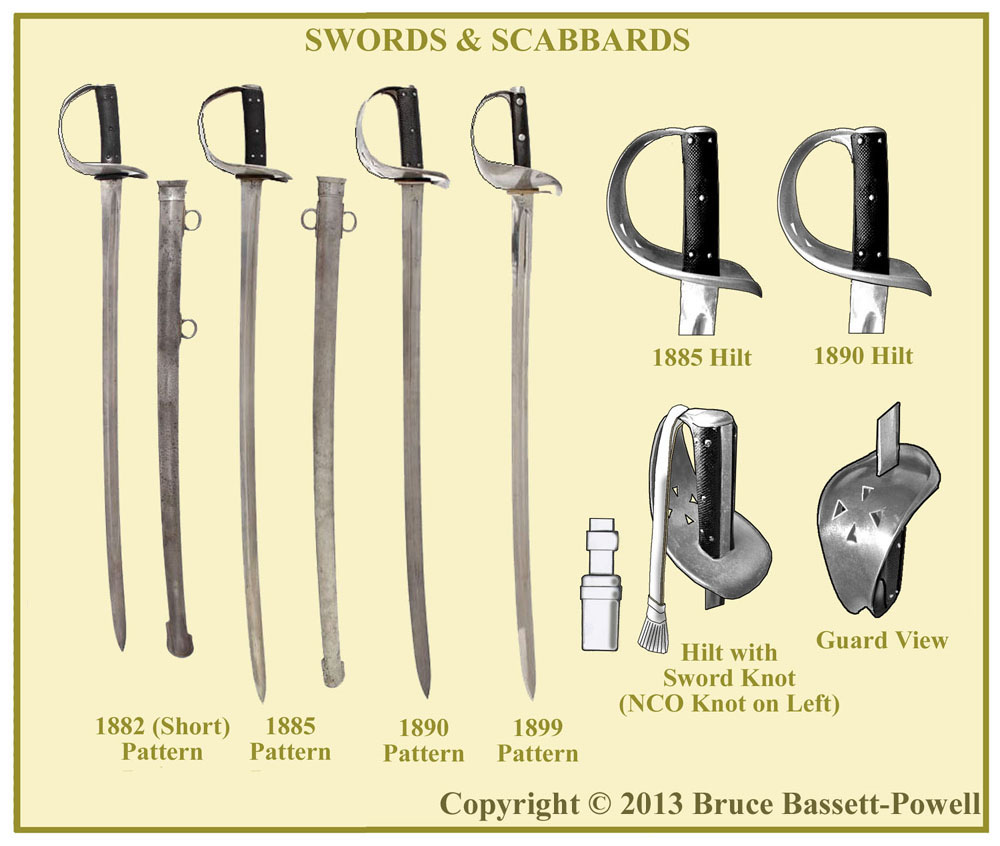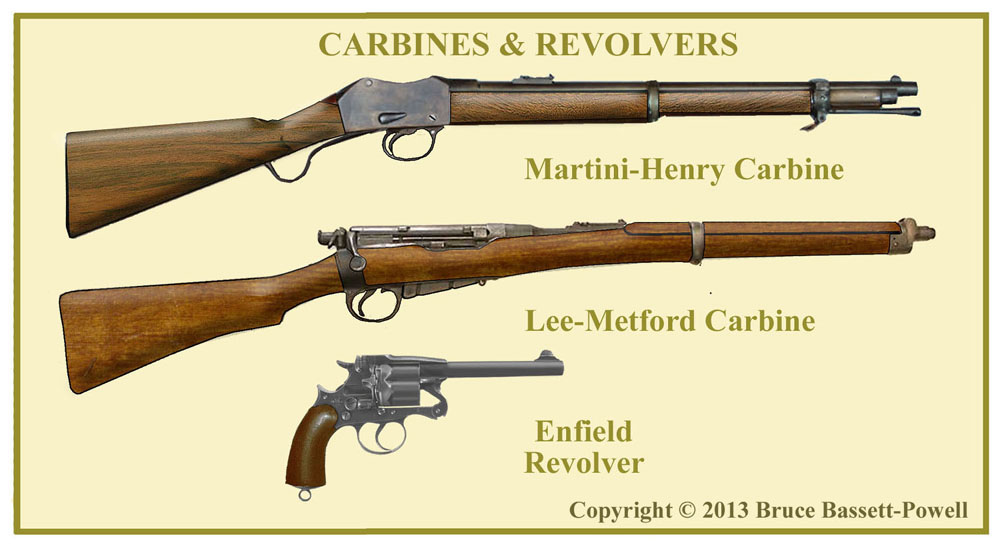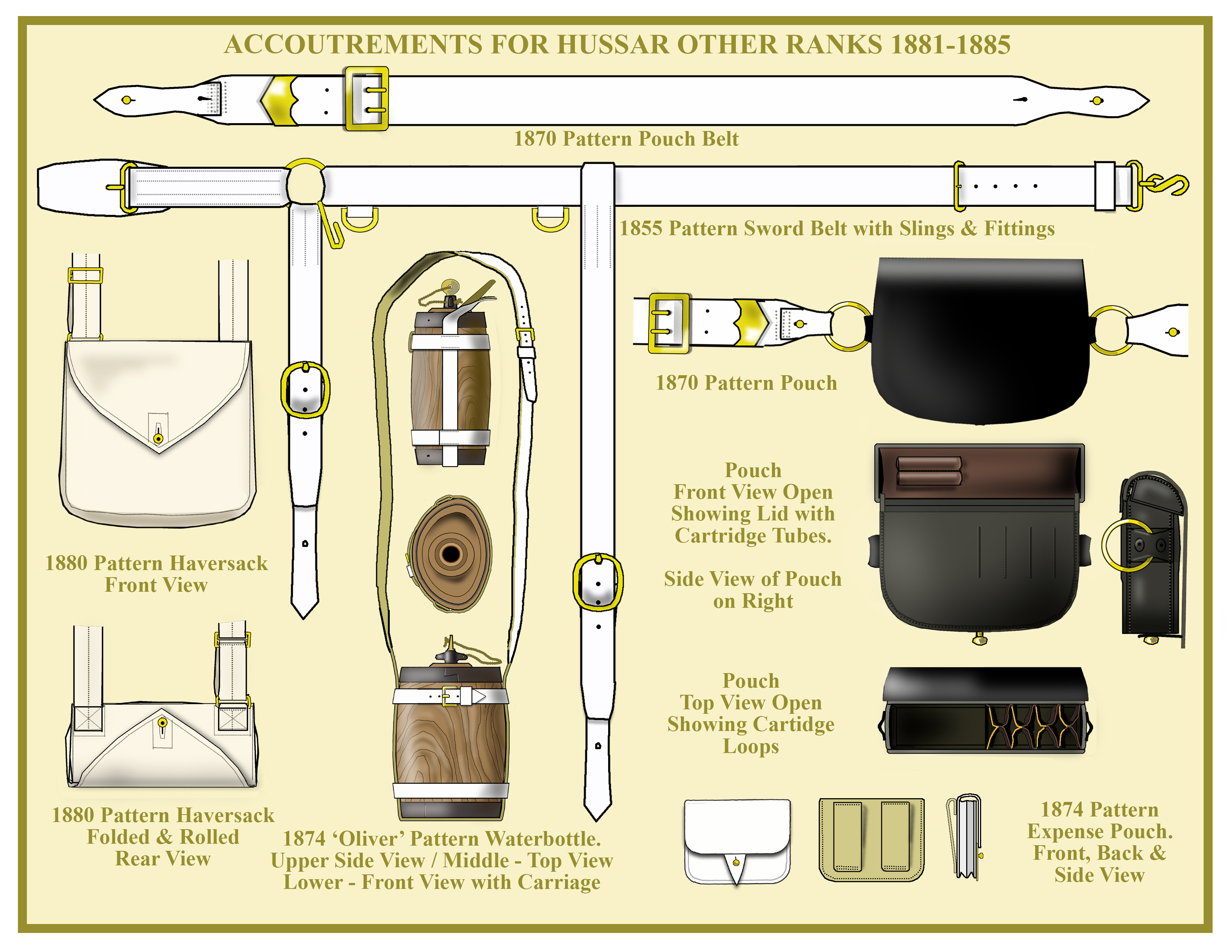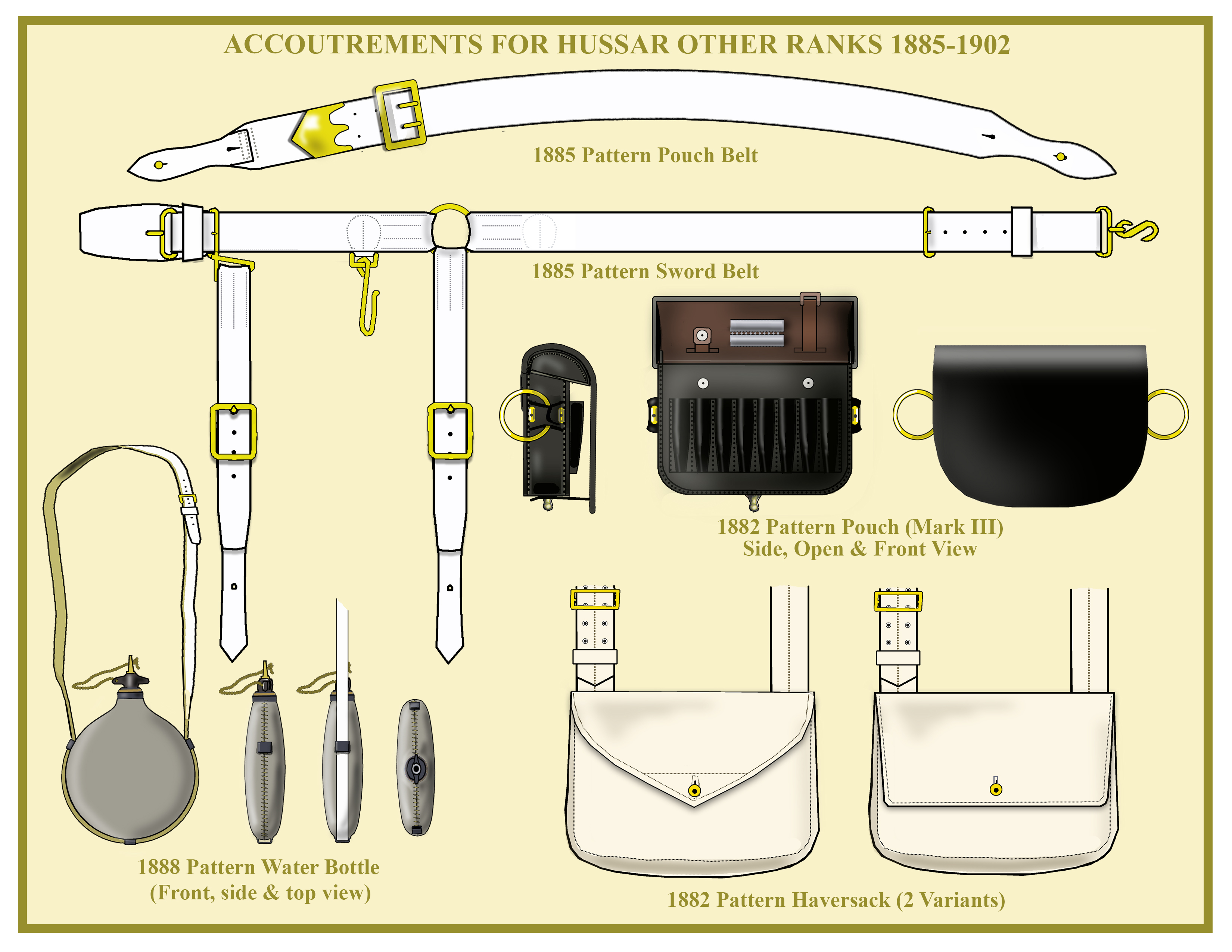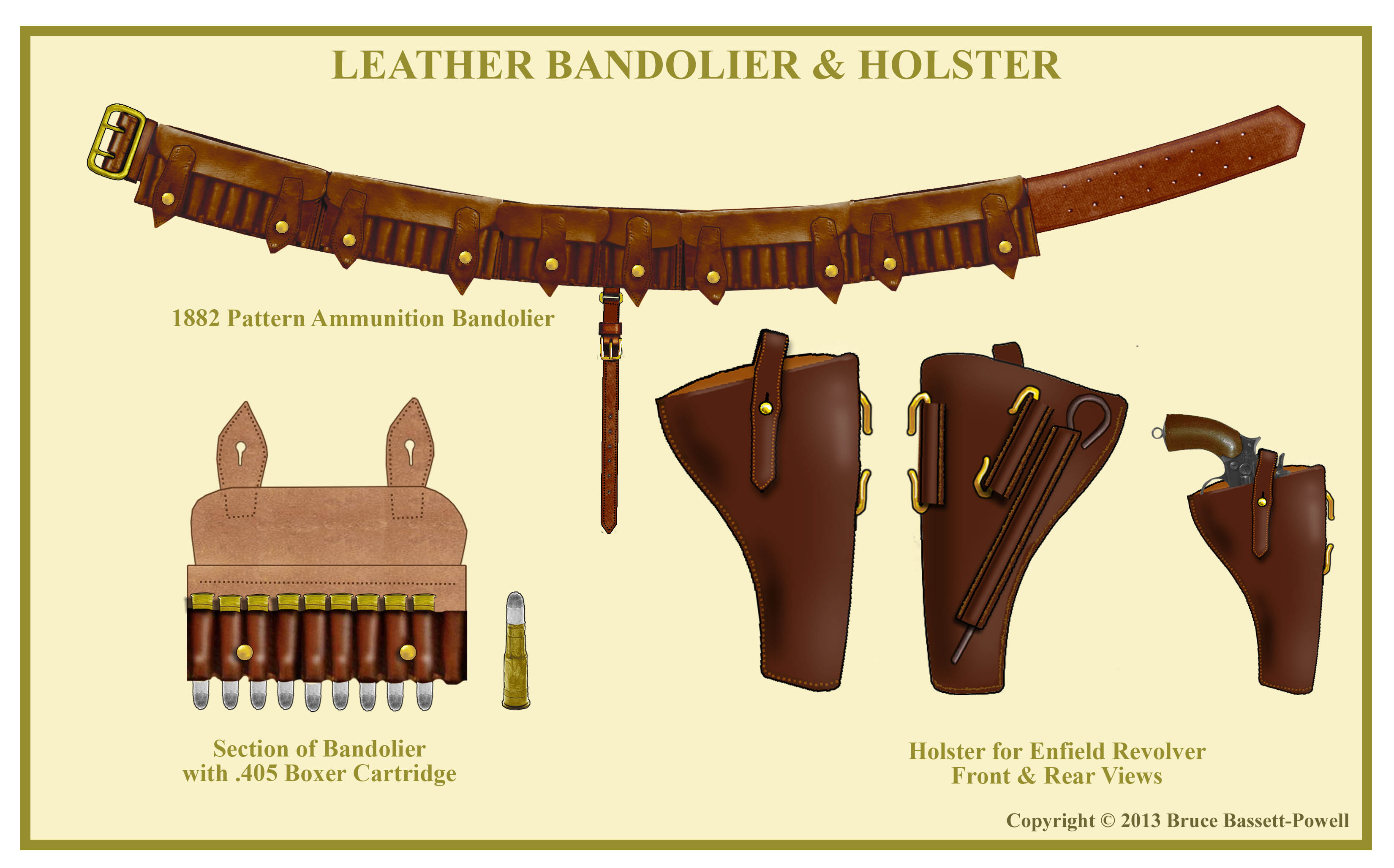WEAPONS AND EQUIPMENT
UNIFORMS, ARMS & EQUIPMENT - HUSSARS
WEAPONS
SWORDS
The first universal sword for the entire cavalry arm was the 1853 pattern which was modified in 1864 to a bowl guard, with pierced Maltese cross, replacing the cast-iron three bar guard (which broke regularly). This was the sword carried in all the conflicts from the Abyssinian campaign to the Egyptian campaign. The 1864 pattern sword was essentially a thrusting weapon and experiences against heavily robed native adversaries in the Third Afghan War and the Egyptian Campaign highlighted these shortcomings. In short, the sword blades were blunt and ineffective as slashing weapons. The 1882 pattern, which came in two lengths (the shorter for light cavalry), proved to be even worse and its failures, along with the infantry bayonet, led to another scandal. On this pattern the sheet steel bowl guard was lapped at the edges thereby preventing the tearing of tunic skirts which was a problem. The howl of outrage to this sword, especially during the Sudan campaign led to another reappraisal and a new testing system which produced the 1885 pattern sword. Apart from an improved and heavier blade it was no better than the 1882 version. Some modifications were made such as a pad at the top of the guard to protect the scabbard mouth. To accommodate the carrying of the sword on the saddle, the rings for the sword slings were fixed to either side of the scabbard mouth. It should be noted that most of the sword and bayonet blades used in the British Army at this time were manufactured in Solingen, Germany. However, the problem always seemed to be design rather than material. More committees and more trials followed before the 1890 pattern sword was authorized. The blade was again made heavier and more fullered and the hilt was further modified with a metal inset between the top of the guard and the grip. This sword was still not much of an improvement, but was carried for over ten years. The 1899 pattern sword, which by the time it had largely been issued was outside the scope of this account, was little different than the 1890 pattern except that the guard was again modified, this time doing away with the Maltese cross piercing and increasing the bowl size over the knuckles.
Ironically, eight years into the next century, the British produced what has been described as “the perfect cavalryman’s sword”. This pattern sword was the last in the British army as its introduction coincided with the demise of cavalry and saw little use during the Great War and it is purely a ceremonial item today.
The swords, with specifications, in use during this period are as follows:
1882 Pattern (long) - Blade Length 35⅜ ins - Weight 2lb 3 oz
1882 Pattern (Short) - Blade Length 33 ins – Weight 2 lb 2.5 oz
1885 Pattern – Blade Length 34 ½ ins – Weight 2 lb 2 oz
1890 Pattern – Blade Length 34 ½ Ins – Weight 2 lb 4 oz
1899 Pattern – Blade Length 34 ½ Ins – Weight 2 lb 9 oz
LANCES
Unlike hussars in Germany and Russia, British hussars did not ever carry the lance either on parade or on campaign in keeping with their true role as light cavalry.
SWORD KNOTS
Hussars, like all British cavalry had a simple sword knot. It was a flat leather strap that was looped through a slit in the bottom of the sword hilt then formed into a fringed tassel at the end. The approximately 15in loop would go around the wrist when in action to prevent the sword falling from the hand. It had changed little since the 18th century. NCOs of cavalry had a plain un-fringed tassel. Before the 1882 pattern sword, the slit was at the top of the guard.
CARBINES & REVOLVERS
Whatever the shortcomings of the British “Arme Blanche”, there was no such problem with the firearms carried by the British cavalry at this time. The Martini-Henry single shot, breech-loading rifle with the lever action, which replaced the Snider breech-loader, was generally issued to the infantry from about 1874 and the carbine version went into production in about 1877 after extensive trials and efforts to reduce the notoriously heavy recoil. A reduced charge somewhat reduced the recoil issue and it was taken into use during the 3rd Afghan War and favourably received by the cavalry regiments who went into action with it. Thereafter the Martini-Henry carbine remained standard until well into the 1890s. It used a 0.450 Boxer cartridge, was 37 ½ ins long and weighed 7 ½ lbs. It was carried by hussars on guard duty, both mounted and dismounted. The Snider carbine was the last carried on a swivel as the Martini was placed in a ‘bucket’ on the off-side of the saddle.
The .45 black powder cartridge was heavy, provided a strong recoil and contributed to the overheating of the Martini barrel. Also, the advent of the magazine now put the single shot feature at a disadvantage. The Lee-Metford bolt-action magazine rifle issued to the infantry from 1888 was issued to cavalry in a carbine version from 1894. This weapon used a .303 cartridge, had a 5 round box magazine, was 40 ins long and weighed 7.7 lbs. The timing of the Lee-Metford was somewhat unfortunate as it still used black powder and smokeless powder was developed soon after. Two years later, the Lee-Metford was converted to smokeless powder and the barrel was replaced by the Enfield version. This produced the first Lee-Enfield rifle followed in 1898 by the carbine version. Most cavalry regiments were using the six-round magazine Lee-Enfield Carbine during the Boer War which was the last cavalry carbine used by the British Army, being replaced by the universal Short Magazine Lee Enfield (SMLE) in 1902-04.
Those NCOs and soldiers permitted to use a side firearm carried the Enfield revolver for most of the period. The carrying of revolvers was also extended to trumpeters and orderlies. The Webley Mark III was issued to certain NCOs after 1895.
Weapons and equipment were generally of universal paterns throughout the cavalry arm. The following description is the same as that presented in the section on Dragoon Guards and Dragoons. There are a few minor details that have been changed to fit usage in Hussar regiments.
EQUIPMENT
Before 1885
The personal load carrying equipment carried by the cavalryman in the eighteen-seventies was much like that worn during the Napoleonic Wars; a wide shoulder belt with a cartridge pouch on the rear, a haversack for rations and personal kit and a water canteen. With the advent of the breech loading carbine in the late sixties, the swivel belt attachment disappeared and the introduction of the Martini-Henry in 1877 required reconfiguration of the pouch to accept the ammunition. British cavalrymen wore the 1857 pattern sword belt and slings with very little modification right through till 1885. In the case of hussars, the belt was worn under the tunic and fitted with two brass loops on the left side because hussars still carried the sabretache until 1888 (NCOs until 1901). Some senior NCOs retained the 1870 pattern belt and slings as, unlike the other ranks, they wore the sword mounted. Often, the sword scabbard was of the previous pattern. The pouch belt was the 1870 pattern which had been modified in small ways, but essentially the same. The pouch also dating from 1870 was modified in 1877 to take the .45 Martini ammunition, by removing the Snider cartridge tubes on the front. The 1882 pouch shown in the illustration was virtually the same. The haversack shown is the 1880 universal pattern for all branches of the army, with a pointed flap replacing the rounded one on the 1867 pattern. Both were worn during the eighteen-eighties. The water canteen carried was known as the “Oliver” pattern water bottle introduced for the entire army in 1874. It had a wooden body with iron loops and white leather carriage system. An expense pouch for quick access to Martini ammunition was issued in 1879. This was attached to the pouch belt. Hussars were not known to have worn a device on their pouches
The After 1885
When the rings on the sword scabbard were moved to either side of the mouth to fit on the shoe-case attached to the saddle, the configuration of the sword belt and slings needed to be changed. This resulted in the 1885 pattern sword belt, which had the same snake clasp on the front but with the rear sling suspended from a ring on the back and the front sling on a moveable brass loop. This was modified slightly in 1888 with more rounded loops. Also in 1885, the pouch belt became curved to more comfortably carry the pouch. The brass fittings were changed slightly. The pouch itself went through several modifications to accommodate the changes in ammunition from .45 to .303. This was the 1892 pattern, Marks I& II followed by the Mark III in 1893 which carried 30 rounds of .303 ammunition. In 1901 the pouch belt and pouch were abolished and the sword belt became an article of equipment worn on full dress ceremonial occasions only.
In 1883 a new pattern general service haversack was authorised which was slightly shallower than the previous version and appeared in types with both rounded and pointed flaps. Needless to say, right up to the late 1890s, both the 1880 and 1883 patterns were carried. The circular iron pattern water bottle encased in light grey cloth was first issued in 1888 to troops overseas. It was not allowed for home service use until the mid-nineties. During the Boer War many were covered in khaki felt.
OTHER RANKS LEATHER EQUIPMENT
The introduction of breechloading firearms to the battlefield inevitably led to vast increases in ammunition expenditure. Bandoliers for extra cartridges soon became necessary and the first made its appearance in 1882. These were at first produced locally and mostly used by mounted infantry but their use by cavalry and other branches soon followed. They were worn by the Camel Corps in the Sudan campaigns and elsewhere. Domestic use began in about 1891 but they seem to have been restricted to mounted infantry. When the pouch and pouch belt began to be discontinued, especially on field exercises, the bandoliers were taken into use. Each bandolier carried 50 rounds in four 10 round pouches and two 5 round ones at the curvature of the waist.
The tubes on the bandolier were shortened twice before 1897 (The last pattern produced) to accommodate changes in ammunition and access. The production of ammunition in 5 round chargers for the Lee-Enfield rifles forced a re-design of the belt from 1901.
The pistol holster for use by other ranks, which by the mid-eighties was senior NCOs and trumpeters plus various orderlies, was an item that survived into the 1930s. First used to accommodate the Enfield revolver it would take most of the Webley marks from 1898 onward.



